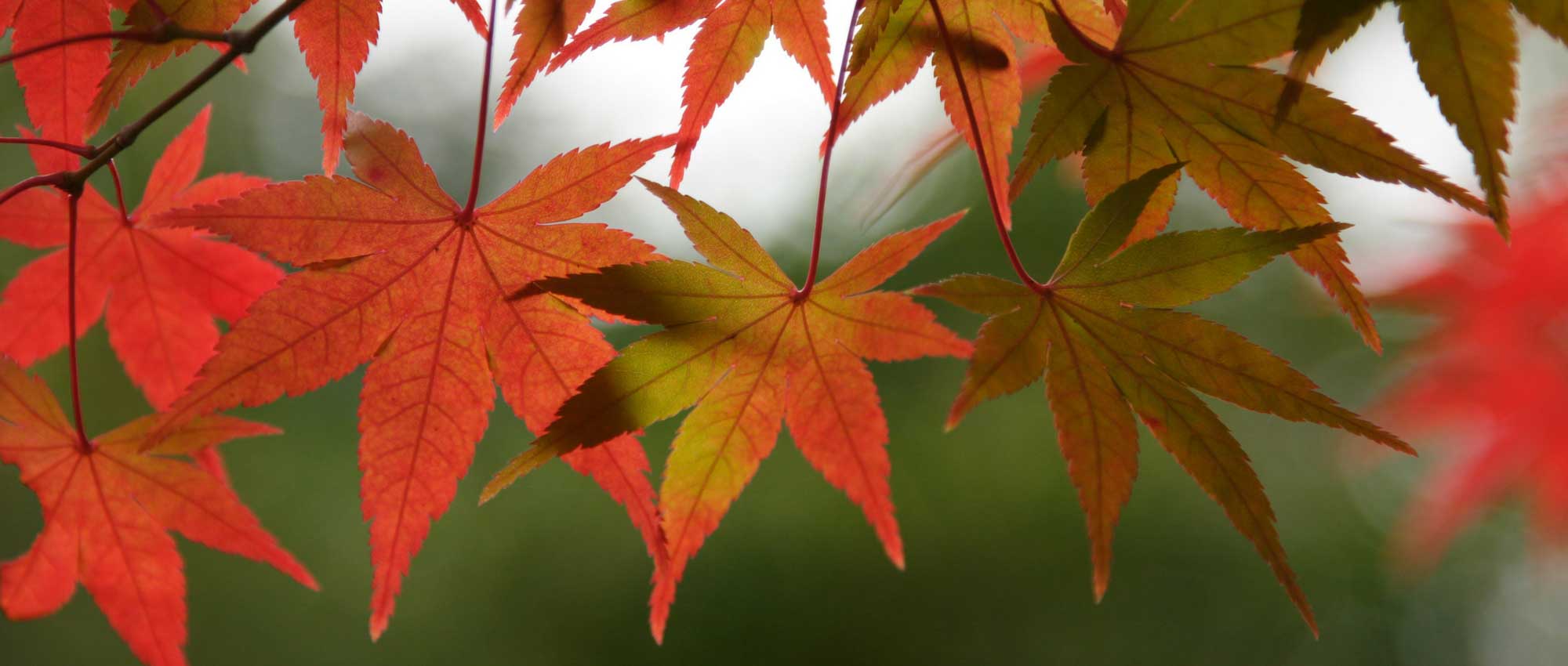
Complete guide to successfully planting and take care of Japanese maple
Where, when, and how to plant?
Contents
The Japanese maple fascinates with its graceful habit and foliage that undergoes spectacular seasonal morphosis. A small tree or large bush emblematic of zen gardens, Acer palmatum charms with its finely dissected leaves and its vibrant autumn colours. Its planting deserves particular attention to ensure its flourishing and to fully enjoy its legendary beauty throughout the seasons. Choice of location, type of soil, ideal period, or even method of planting in pots or in open ground: your success depends on these essential elements. Discover our recommendations for a successful planting of your Japanese maple and create a haven of serenity in your garden!
Find our complete sheet: Japanese maple: planting, pruning, and maintaining
What exposure should you choose for your Japanese maple?
Dappled shade, the ideal exposure for Acer palmatum
Dappled shade provides the perfect exposure for your Japanese maple, offering the necessary brightness without being harsh. This privileged position, beneath the light canopy of larger trees or in a clear underwood, allows the foliage to develop its most beautiful colours without the risk of scorching.
In a southern climate, a shading veil proves invaluable during periods of intense heat to maintain soil freshness. Cultivars with purple or variegated foliage particularly appreciate this moderate exposure, which enhances their hues while protecting their delicate plant material.
Protection from direct sunlight and wind
Protect your Japanese maple from the scorching rays of the sun, especially between 12pm and 4pm when the foliage is at risk of drying out. A temporary shading veil is invaluable during the early years of slow growth. Desiccating winds pose another threat to these delicate bushes. A windbreak hedge or the proximity of a protective wall provides ideal shelter without creating excess moisture at the base of the tree. For potted specimens, choose a sheltered spot on your terrace, where cultivation fits perfectly into small spaces while allowing you to move the bush according to the seasons.
The secrets to a successful planting
Choosing the Right Compost and Soil
The ideal substrate for your Japanese maple combines several elements with complementary properties. A balanced mix of heather soil and planting compost promotes harmonious root development. For optimal growth, prepare a substrate consisting of one third heather soil, one third organic-rich compost, and one third coarse sand, ensuring excellent drainage. Pumice, incorporated in small quantities, improves soil aeration and prevents excess water. A mulch of pine bark on the surface maintains the freshness and acidity necessary for your Acer palmatum to thrive.
The Ideal Time to Plant
Autumn offers the best conditions to plant your Japanese maple, when the soil still retains summer warmth. This season allows the roots to develop quietly before the first frosts, thus preparing for vigorous growth in early spring. In mild climates, planting remains possible until the end of November.
Container-grown Japanese maples can also join your garden in spring, as soon as the risk of frost has passed. In this case, regular watering and protective mulching are essential to get through the first summer period. A temporary shading cloth will protect the young plant from the sun’s intensity during its establishment.
Key Steps for Planting
Start by digging a hole twice as wide as the root ball and equally deep. This generous dimension allows the roots of your new bush to easily colonise the surrounding soil. Place a draining layer of gravel or pumice at the bottom, especially in clayey soil.
Gently position your plant, ensuring that the collar is level with the soil surface. A flexible stake, installed facing the prevailing winds, will guide its growth during the first few years. Fill in with the prepared substrate mix without compacting excessively.
A generous mulch of pine bark completes the installation, forming a circle 50 cm around the trunk. A thorough watering finalises the planting, creating optimal contact between the roots and the nourishing soil.
Discover other Japanese Maples
View all →Available in 6 sizes
Available in 1 sizes
Available in 1 sizes
Available in 1 sizes
Available in 1 sizes
Available in 4 sizes
Available in 1 sizes
Available in 3 sizes
Available in 2 sizes
Available in 3 sizes
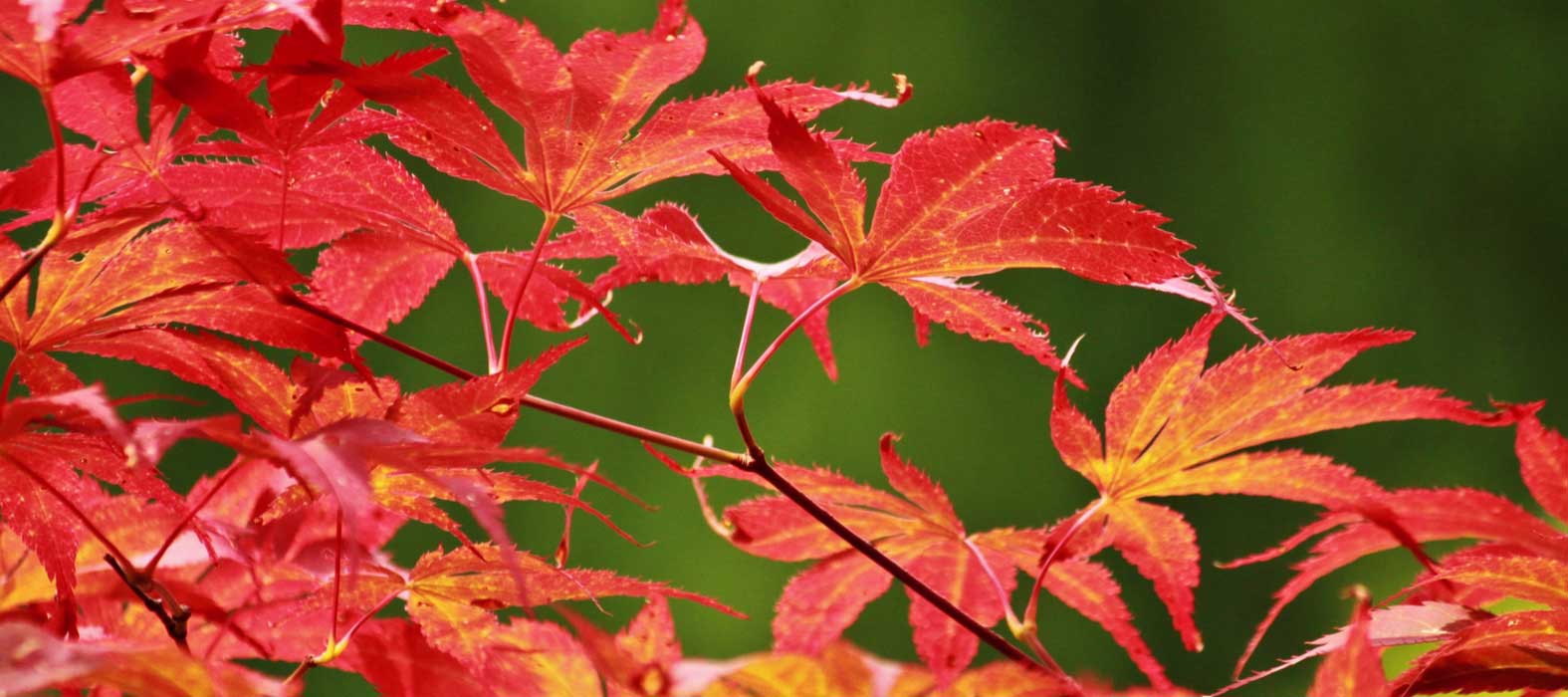
Pot or ground cultivation
The Specifics of Container Cultivation
Dwarf and compact varieties thrive beautifully in containers, offering the possibility to create a zen garden even on a small balcony. A terracotta pot with a diameter of 40 to 50 cm, with drainage holes, is the ideal support. The growing mix combines 60% heather soil and 40% pumice, ensuring perfect aeration of the roots.
Regular but moderate watering keeps the substrate fresh without excess stagnant water. A decorative gravel mulch on the surface limits evaporation while adding a mineral touch characteristic of Asian gardens. A light fertilisation in spring, with an organic fertiliser for acidophilous plants, supports harmonious foliage growth.
Designing in Beds or Gardens
Japanese maple naturally enhances beds of ericaceous plants, where its airy foliage contrasts with the rounded volumes of azaleas and rhododendrons. Its graphic silhouette takes on full dimension at the back of the bed, while ferns and hostas elegantly carpet the ground at its feet. A pine bark mulch maintains the necessary freshness and acidity for the entire bed.
The choice of location is crucial for creating a scene evocative of zen gardens. A partially shaded position, near a wall or rockery, highlights the natural structure of the tree. Light gravel, arranged in concentric circles around the trunk, enhances the meditative atmosphere typical of Asian garden styles.
Seasonal Maintenance
Watering and Water Requirements
Moderate but regular watering maintains the vigour of the foliage of your Acer palmatum. Watering should preferably be done with rainwater or demineralised water, as lime is not well tolerated by the roots. In spring, monitor the surface soil moisture and water as soon as the top few centimetres dry out.
Summer heat requires increased vigilance, especially in full sun where two waterings per week may be necessary. Morning misting of the foliage refreshes the atmosphere and prevents spider mite attacks. A mulch of pine bark, renewed each spring, helps retain moisture at the base of the bush.
Fertilisation and Recommended Fertilisers
To support the harmonious growth of your Acer palmatum, moderate fertilisation in spring is usually sufficient. A slow-release organic fertiliser, such as ground horn or dried blood, provides essential nutrients without risking root burn. Applications should be made in March-April, when the buds begin to swell.
Varieties grown in pots benefit from a second light fertilisation in June, using a special acidophilous plant fertiliser. A measured dosage prevents overly vigorous growth that could weaken the bush against winter frosts. Composts and manures should be avoided as they can promote the appearance of fungi at the roots.
Winter Protection Against Frost
Japanese maple varieties show a good natural resistance to cold, tolerating temperatures down to -15°C during dormancy. However, winter protection is valuable for young specimens and container-grown plants, which are more vulnerable to late spring frosts.
Protection begins in autumn with a gradual reduction in watering, allowing the tissues to concentrate for winter. A generous mulch of pine needles or fallen leaves protects the root zone from freeze-thaw cycles.
For maples grown in containers, moving them to a sheltered spot against a wall or under a roof overhang limits the impact of drying winds. Specimens in the ground benefit from light protection of the branches with a non-woven cover, particularly effective against spring frosts that threaten young shoots.
The most beautiful varieties to choose from
Red and Purple Leaf Maples
Flamboyant hues adorn the purple cultivars of the Aceraceae family, creating a vibrant tableau that evolves with the seasons. Acer palmatum ‘Bloodgood’ displays intense purple foliage from spring, darkening in summer before bursting into scarlet red in autumn. More compact, ‘Shaina’ boasts dense crimson red leaves, while the elegant ‘Trompenburg’ captivates with its deeply lobed leaves.
These varieties reach their peak during the autumn metamorphosis, their foliage adorned with incandescent shades ranging from vermilion to garnet. ‘Fireglow’ particularly illuminates gardens with its bright burgundy foliage that literally ignites red in autumn, creating a fascinating spectacle until the last days of the season.
Green and Variegated Cultivars
Japanese maples with green leaves bring a touch of freshness and serenity to the garden. ‘Viridis’ unfurls finely dissected light green foliage that undulates gracefully with the slightest breeze. To brighten shaded areas, variegated varieties like ‘Butterfly’ adorn their green leaves with elegant cream-white margins, creating a natural lace effect.
The ‘Ukigumo’ stands out with its spectacular young shoots tinged with pink and white against a green backdrop, offering a changing tableau throughout the seasons. These more delicate cultivars require partial shade to maintain the clarity of their variegation and prevent leaf burn.
Pruning and growth
The moderate growth rate of the Japanese maple, at 15 to 30 cm per year, makes it easy to manage in the garden. Its naturally graceful silhouette requires little intervention, with pruning limited to the removal of dead or poorly placed branches. A light thinning at the end of winter aerates the structure and highlights the most beautiful branchings.
Young specimens require gentle formative pruning in spring, just after the first leaves appear, to guide their development harmoniously. Cuts, always clean and angled, should be made above a bud facing outward. An application of healing paste protects significant wounds and prevents the establishment of fungal diseases.
Common diseases and issues
Leaves that suddenly turn brown and branches that dry out often signal the presence of verticillium wilt, a formidable fungal disease for Japanese maples. Mealybugs and aphids can also weaken your Acer palmatum by colonising the underside of the leaves. A spray of diluted black soap is usually sufficient to eliminate them.
Regular monitoring of your maple allows for the quick detection of black spots on the leaves or a characteristic white fluff indicative of powdery mildew. A preventive treatment with nettle manure naturally strengthens the bush’s defences. Planting in well-drained soil and moderate pruning significantly reduces health risks.
How to plant it?
If you live in a humid area or your soil is heavy and clayey, don’t hesitate to plant on a mound to facilitate water drainage.
- Start by placing the root ball in a basin filled with water to moisten it.
- Using a spade, dig a hole large enough, ideally four times wider than the root ball.
- Add a mixture of garden soil, well-decomposed compost, and heather soil, to which you will add gravel or coarse sand to allow for drainage.
- Position the root ball in the planting hole, placing the collar very slightly above soil level.
- We recommend installing a stake to keep the maple securely in place.
- Replace the soil around the root ball and gently firm it down.
- Water.
- Install a layer of mulch to keep the soil cool and also to protect it from the cold.
You can also plant your Japanese maple in a pot. This is actually a good solution if your soil is not suitable for growing these maples: too chalky, too clayey, etc. Choose a pot that is two to three times wider than the root ball. Be sure to place a layer of gravel at the bottom to allow for drainage. Plant in a rich substrate, to which you can add some pine bark. It is important that the substrate retains water, as in a pot, it is likely to dry out much more quickly than in the ground. For this same reason, you will need to water regularly while allowing the substrate to dry out between waterings.
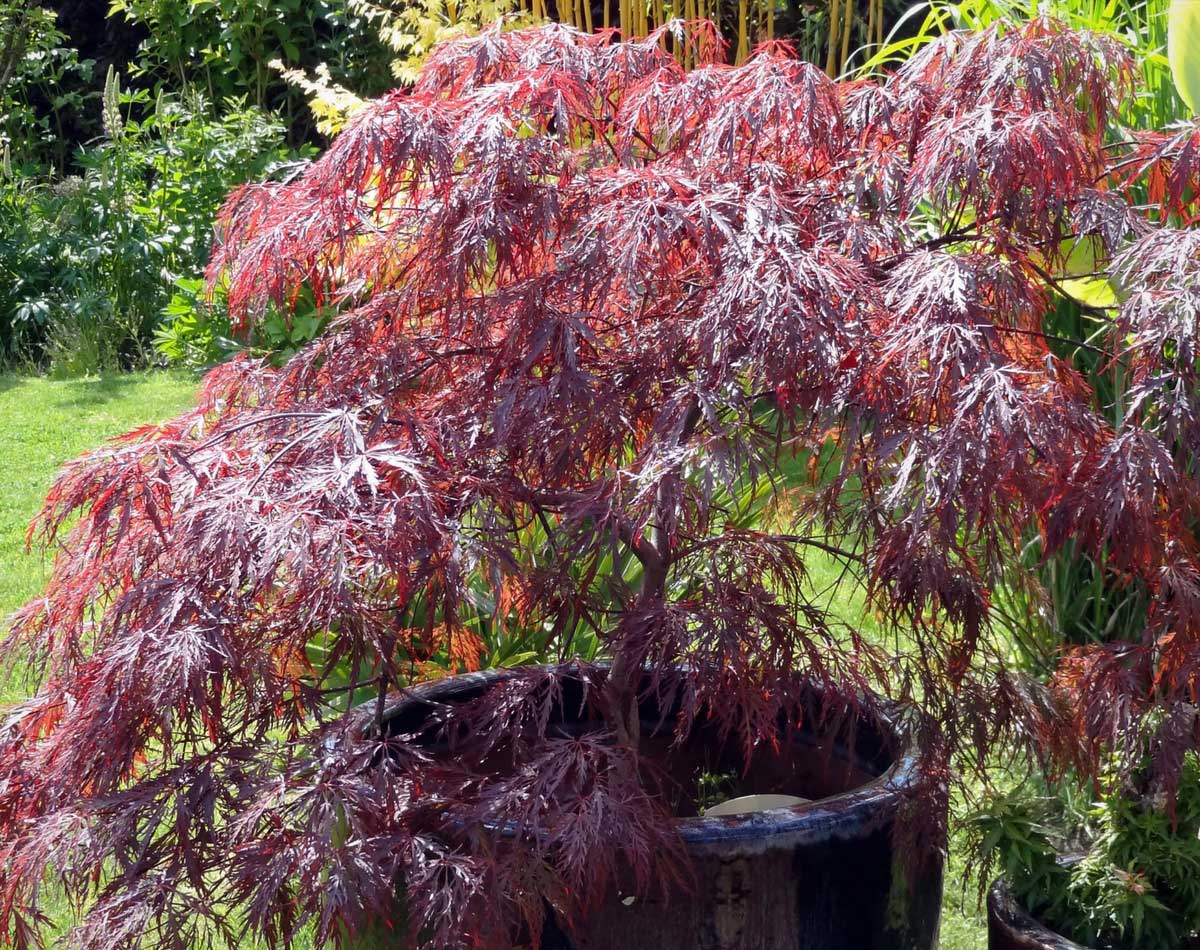
You can certainly plant your Japanese Maple in a pot! Here, Acer palmatum ‘Inaba Shidare’
- Subscribe!
- Contents
































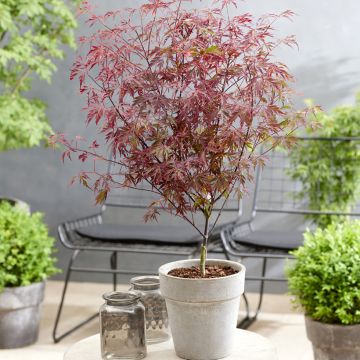

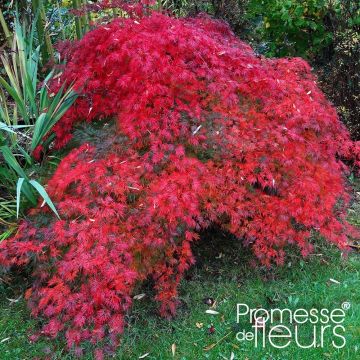
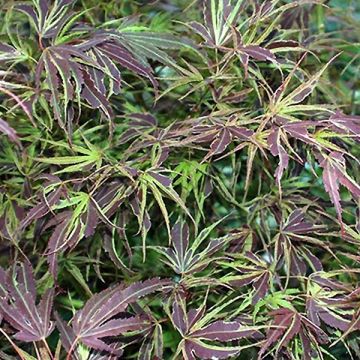


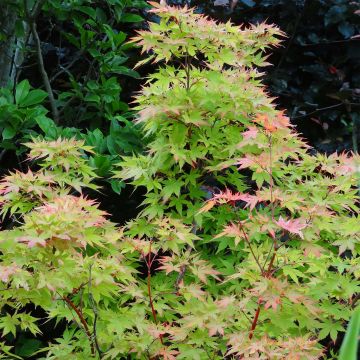
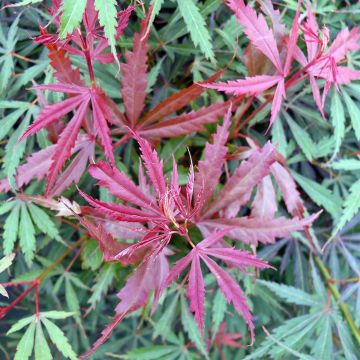
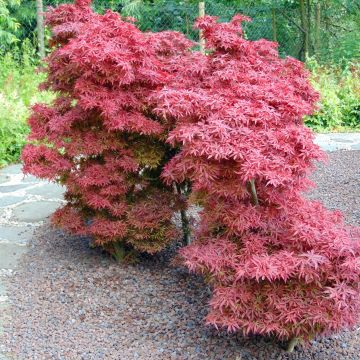
Comments